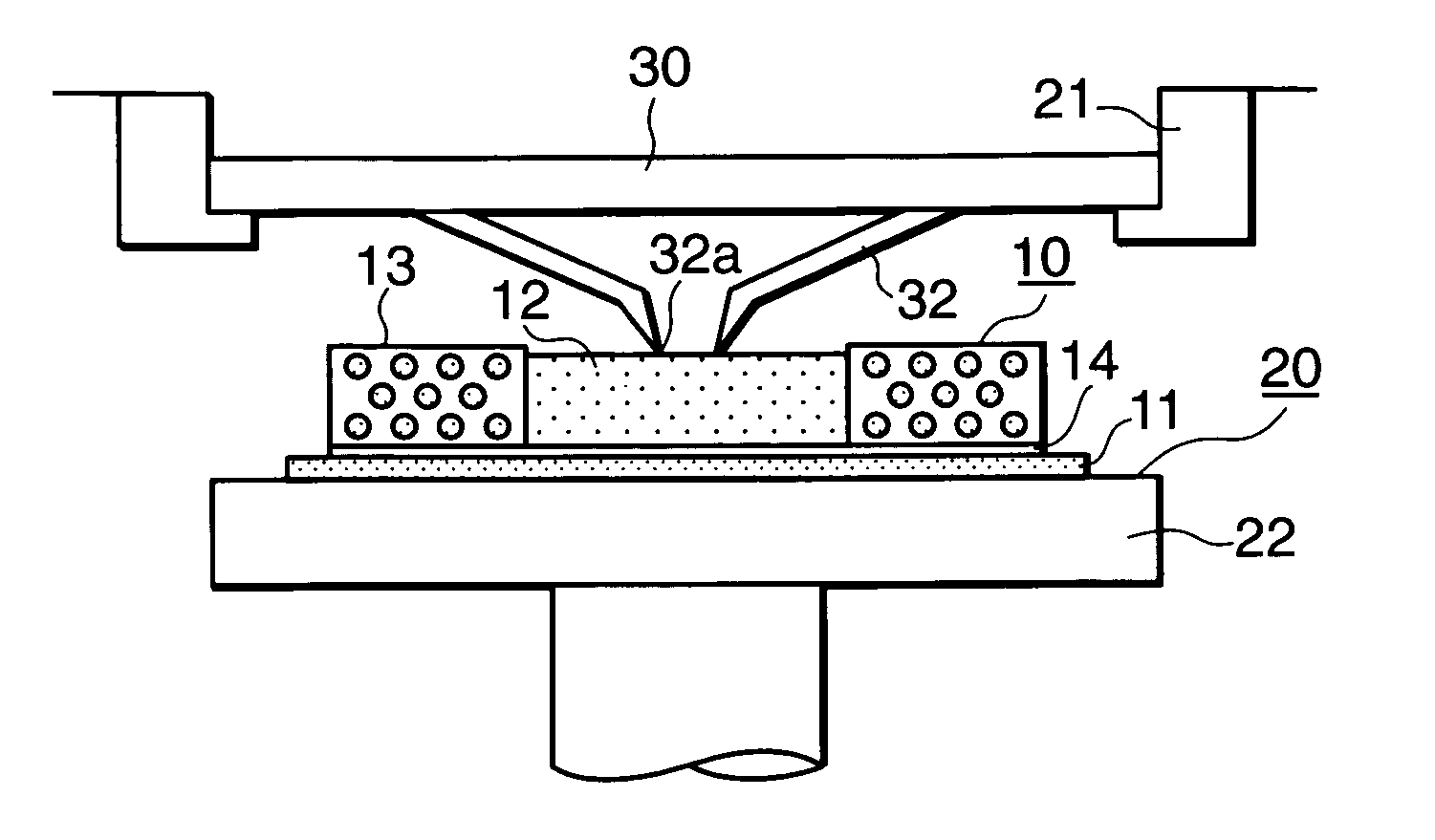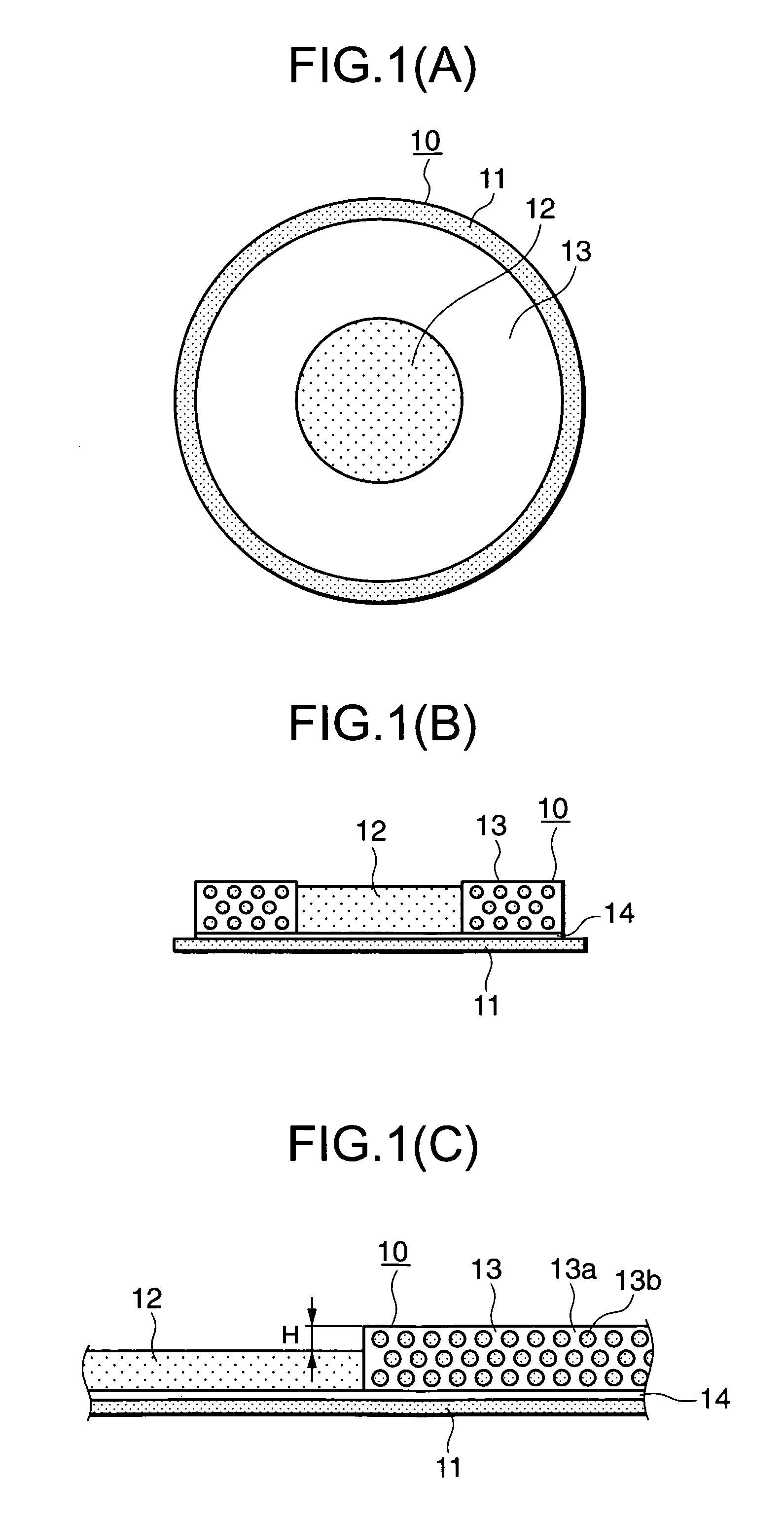Cleaning sheet for probe needles
a technology for cleaning sheets and needles, applied in carpet cleaners, semiconductor/solid-state device testing/measurement, instruments, etc., can solve the problems of inability to use needles, inability to polish the tip sections of needles that need sufficient polishing to ensure contactability, and low polishing effect of each needle tip section. , to achieve the effect of greatly shortening the polishing processing time interval, automatic execution of effective needle tip polishing
- Summary
- Abstract
- Description
- Claims
- Application Information
AI Technical Summary
Benefits of technology
Problems solved by technology
Method used
Image
Examples
first preferred embodiment
(Configuration)
[0027]FIGS. 1(A) through 1(C) are configurational views of a cleaning sheet for probe needles, showing a first embodiment of the present invention. FIG. 1(A) is a surface view thereof as seen from above, FIG. 1(B) is a vertical cross-sectional view thereof, and FIG. 1(C) is a partly vertical-sectional enlarged view thereof, respectively.
[0028]The cleaning sheet 10 has a disc-shaped substrate 11 such as a wafer. A circular first polishing layer 12 is disposed in a central portion thereof on the substrate 11. A second polishing layer 13 is disposed on a concentric circle at its peripheral portion. These first and second polishing layers 12 and 13 are bonded onto the substrate 11 with an adhesive 14. The first polishing layer 12 has a surface formed in a surface-roughened fashion (e.g., a sandpaper fashion) to polish a tip section of each probe needle and has the function of principally removing adherents leading to inhibition of electrical conduction, which have been ad...
second preferred embodiment
(Configuration)
[0041]FIGS. 3(A) through 3(C) are configurational views of a cleaning sheet for probe needles, showing a second embodiment of the present invention. FIG. 3(A) is a surface view thereof as viewed from above, FIG. 3(B) is a vertical cross-sectional view thereof, and FIG. 3(C) is a partly vertical-sectional enlarged view thereof, respectively.
[0042]It is considered that since the area for polishing the tip sections of the probe needles 32 and the area for polishing the whole needlepoints are largely divided into the two like the polishing layer 12 at the central portion of the round sheet and the polishing layer 13 at its peripheral portion in the cleaning sheet 10 according to the first embodiment, the distance over which the probe needles 32 move on the cleaning sheet 10, increases upon executing the polishing and the processing time becomes long. Therefore, the present embodiment is set to a structure having two functions for alternately disposing, at intervals of wid...
third preferred embodiment
[0052]FIG. 5 is a surface view of a cleaning sheet for probe needles showing a third embodiment of the present invention, as viewed from thereabove.
[0053]The present cleaning sheet 10A is a modification of the first embodiment. A semicircular first polishing layer 12A and a semicircular second polishing layer 13A both divided into two are disposed over a disc-shaped substrate 11. These first and second polishing layers 12A and 13A are adhered onto the substrate 11. The first polishing layer 12A has a sandpaper-like surface and polishes the tips of the needlepoints 32a. The second polishing layer 13A is a sponge-like layer containing polishing grains and polishes the whole needlepoints with the needlepoints 32a being stuck therein.
[0054]In a polishing process using the prober 20, the probe needles 32 are moved from the first polishing layer 12A to the second polishing layer 13A and pressed against the second polishing layer 13A. Alternatively, the probe needles 32 are moved from the ...
PUM
 Login to View More
Login to View More Abstract
Description
Claims
Application Information
 Login to View More
Login to View More - R&D
- Intellectual Property
- Life Sciences
- Materials
- Tech Scout
- Unparalleled Data Quality
- Higher Quality Content
- 60% Fewer Hallucinations
Browse by: Latest US Patents, China's latest patents, Technical Efficacy Thesaurus, Application Domain, Technology Topic, Popular Technical Reports.
© 2025 PatSnap. All rights reserved.Legal|Privacy policy|Modern Slavery Act Transparency Statement|Sitemap|About US| Contact US: help@patsnap.com



